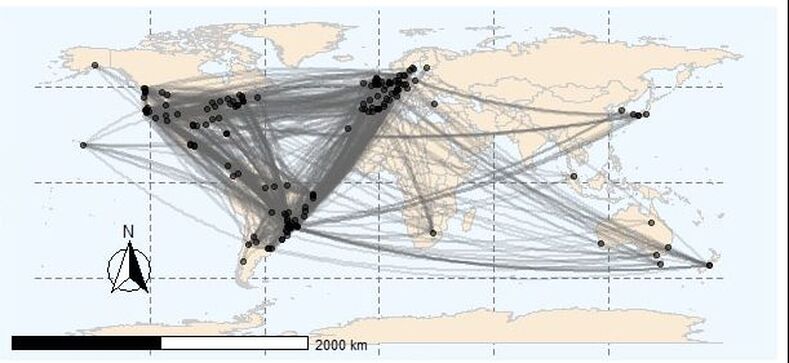Photo by João Paulo Krajewski
Our research
Biological, physical, technological, and social systems are formed by interacting units.
Network science allows one to explore the consequences of the patterns of interaction of these systems to different types of dynamics, such as information and innovation flow in societies, epidemics spreading, failure cascades in technological systems, commodity flow, disease development within organisms, and indirect effects in ecosystems. In this context, the main scientific problem we explore in our lab is how ecological interactions affect and are affected by evolutionary and coevolutionary dynamics.
We address this problem by integrating empirical data on ecological interactions, network science, and different types of evolutionary models. We also explore the consequences of network structure to other forms of dynamics, such as coextinction and population dynamics, and to other forms of networks at different levels of biological organization, from genes to ecosystems and its interactions with human populations.
If you want to know about our coevolutionary model, please refer to our introductory text with codes (in R) for simulations. Additional material about our models are available at Lucas Medeiros's github.
Our research program is based upon a network of collaborators around the world. We are deeply thankful for the opportunity of learning from these researchers. In the map below, nodes depict cities in which our collaborators or us are located. Links indicate that that at least a study was coauthored by researchers located in both cities.
Selected publications (lab members and co-supervised students in bold)
Network science allows one to explore the consequences of the patterns of interaction of these systems to different types of dynamics, such as information and innovation flow in societies, epidemics spreading, failure cascades in technological systems, commodity flow, disease development within organisms, and indirect effects in ecosystems. In this context, the main scientific problem we explore in our lab is how ecological interactions affect and are affected by evolutionary and coevolutionary dynamics.
We address this problem by integrating empirical data on ecological interactions, network science, and different types of evolutionary models. We also explore the consequences of network structure to other forms of dynamics, such as coextinction and population dynamics, and to other forms of networks at different levels of biological organization, from genes to ecosystems and its interactions with human populations.
If you want to know about our coevolutionary model, please refer to our introductory text with codes (in R) for simulations. Additional material about our models are available at Lucas Medeiros's github.
Our research program is based upon a network of collaborators around the world. We are deeply thankful for the opportunity of learning from these researchers. In the map below, nodes depict cities in which our collaborators or us are located. Links indicate that that at least a study was coauthored by researchers located in both cities.
Selected publications (lab members and co-supervised students in bold)
- Almeida-Neto, M., P. Guimaraes, P. R. Guimarães, R. D. Loyola, W. Urlich. 2008. A consistent metric for nestedness analysis in ecological systems: reconciling concept and measurement. Oikos 117: 1227-1239.
- Andreazzi, C., J. N. Thompson, P. R. Guimarães. 2017. Network structure and selection asymmetry drive coevolution in species-rich antagonistic interactions. American Naturalist 190: 99-115
- Assis, A. P. A., J. N. Thompson, P. C. Santana, P. Jordano, J. Bascompte, P. R. Guimarães. Genetic correlations and ecological networks shape coevolving mutualisms. Ecology Letters 23: 1789-1799
- Burin, G., P. R. Guimarães, T. B. Quental. 2021. Macroevolutionary stability predicts interaction patterns of species in seed dispersal networks. Science 372: 682-683.
- Cosmo, L.G., A. P. A. Assis, M. M. Pires, M. A. Aguiar, A. Valido, P. Jordano, J. N. Thompson, J. Bascompte, P. R. Guimarães. Indirect effects shape species fitness in coevolved mutualistic networks. Nature (in press).
- Galetti,M., R. Guevara, M. C. Cortes, R. Fadini, S. Von Matter, A. B. Leite, F. Labecca, T. Ribeiro, C. S. Carvalho, R. G. Collevatti, M. M. Pires, P. R. Guimarães, P. H. Brancalion, M. C. Ribeiro, P. Jordano. 2013. Functional Extinction of Birds Drives Rapid Evolutionary Changes in Seed Size. Science 340: 1086-1090.
- Guimarães, P. R. 2020. The structure of ecological networks across levels of organization. Annual Review of Ecology, Evolution, and Systematics 51:433-460.
- Guimarães, P. R., M. M. Pires, P. Jordano, J. Bascompte, J. N. Thompson. 2017. Indirect effects drive coevolution in mutualistic networks. Nature 550: 511–514.
- Guimarães, P.R., P. Jordano, J. N. Thompson. 2011. Evolution and coevolution in mutualistic networks. Ecology Letters 14:877-885.
- Guimarães, P. R., M. Galetti, P. Jordano. 2008. Seed dispersal anachronisms: rethinking the fruits extinct megafauna ate. PLoS ONE 3: e1745.
- Guimarães, P. R., V. Rico-Gray, P. S. Oliveira, T. J. Izzo, S. F. dos Reis, J.N. Thompson. 2007. Interaction intimacy affects structure and coevolutionary dynamics in mutualistic networks. Current Biology 17: 1797-1803
- Medeiros, L. P., G. Garcia, , J. N. Thompson, P. R. Guimarães.2018. The geographic mosaic of coevolution in mutualistic networks. Proceedings of the National Academy of Sciences USA 115: 12017-12022.
- Pires, M. M., P. L. Koch, R. A. Farina, M. A. M. de Aguiar, S. F. dos Reis, P. R. Guimaraes . 2015. Pleistocene megafaunal interaction networks became more vulnerable after human arrival. Proceedings of the Royal Society B 282: 20151367
- Raimundo, R. L. G. , P. R. Guimaraes , D. M. Evans. 2018. Adaptive Networks for Restoration Ecology. Trends in Ecology and Evolution 33: 664-675.
- Yeakel J. D, M. M. Pires, L. Rudolf, N. J. Dominy,P. L. Koch, P. R. Guimaraes, T. Gross. 2014. Collapse of an ecological network in Ancient Egypt. Proceedings of the National Academy of Sciences USA 111: 14472-14477
Artwork by Rodolfo G. Batista


